Some Turtles Have Nice Shells
by Roger D. Beck
Self-Published in 2002
ISBN 0-9714103-6-4
Four Score and Seventy square feet ago….
No really….
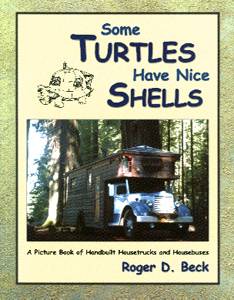
Sharkey’s Book Review of…
Small structures and living spaces are finally getting the recognition they deserve, although there was and still is a sub-set of owners of such that adopted the technique out of necessity. You see our foundations were restricted to no more than eight feet of width and a length of no more than forty feet. Of course, I am referring to small homes built on vehicle chassis, specifically Housetrucks and Housebuses. Many of the owner-builders went to great lengths to finish and furnish their creations with the finest materials and antiques available at the second hand store!
Roger Beck’s much-awaited, often-touted, long sought-after new journal of the craft, “Some Turtles Have Nice Shells” is finally back from the printer’s and it is LOOKING GOOD! It’s a big relief to see this book finally finished.
The process of getting all of the details perfected has been daunting to say the least. Once Roger had done all of the layout and paste-up, the book was turned over to a printer’s agent, who found that the format of the computer files was wrong and that the hundreds of photos that Roger had scanned would have to be re-scanned in a higher resolution. Even once the book had been resubmitted in the correct file format, the initial proof pages showed that a lot of correction was going to be necessary to make the photos appear properly. An additional (and expensive) enhancement process was applied to all of the images, and the proof pages returned for Roger’s evaluation. Still not satisfied with the color and brightness/contrast of many of the photos in printed form, Roger ordered several more rounds of adjustments before the finished product was deemed “ready-to-print”. What all of this means to purchasers of the book is that the quality of the images, the paper and even the binding are all top-notch.
Now that the mechanics of making the book are out of the way, here’s a peek into what’s inside:
I’ve known Roger Beck for years. It was way back in, oh, let me think, 1999, when we first met. Honestly, how two housetruckers with similar interests and shared acquaintances could live in and around the same small city for 25 years and never cross paths….. but that’s another story. The point is, when we did meet, Roger had album after album after album of photos of house trucks and buses. Roger had always wanted to assemble his photos into a book, but never quite found the time to do it. When I told him how much a tattered copy of Jane Lidz’s “Rolling Homes” fetches these days, he was outraged, energized, and inspired, all at once. Roger bought a computer, learned to use it (very well) and scanned many of his photos, doing the layout and researching additional information to feather out his book-to-be into the compleat house truck and bus journal. I often times tell him he didn’t write a book about house trucks and buses, he wrote a dag-blamed encyclopedia.
Anyway, on to the enecyclo…uh, book. This is not a thin collection of widely-spaced images held together with clip art. At 192 pages and nearly 400 photographs, the reader is sure to get a very solid taste of what the housetruck culture was and is about. Both exterior and interior views are presented for the majority of the vehicles depicted, and whenever possible, the identity of the owner is tastefully presented to assist the reader in identifying the truck or bus further into the pages
The book includes construction photograph sequences of Roger’s fourth housetruck, built on a 1952 Federal 5 ton truck chassis, and the roof-raising of Sam’s 1951 White school bus. Either of these photographic essays with accompanying text will prove invaluable to someone considering building their own truck or bus. The many, many images of a wide variety of vehicles serves the reader as a “wish book” and design guide, suggesting a multitude of ideas and options to the would-be builder. Even the casual reader who wishes no more than to browse images of unique and functional small homes will be delighted in the contents of this book.
Roger has put a lot of work into this project and has self-published his book. The price of Some Turtles Have Nice Shells is $29.95, which makes it affordable for common folk. The book can be purchased through Roger’s web site, the address of which appears at the bottom of this review. It is also available through a variety of book sellers, including Powell’s Books, and Roger frequently lists copies of the book on eBay.
Roger was a member of a loose association of crafters known as the Northwest Trading Company, which traveled the Western United States, making stops at craft fairs, where the members would display and market their wares. Trucks and buses were the favored means of transportation of these crafts persons, as they provided shelter, conveyance, shop space and retail display area in one package.
Eugene, Oregon in the 1970’s was ground zero for Northwest Trading Co. and house trucks and buses in general. Fortunately for us all, Roger chronicled much of the construction and habitation of these vehicles with his photographic skills.
Pages 88 through 103 of the book consist of a construction diary of Roger’s fourth housetruck. Following are a few excerpts from that section.
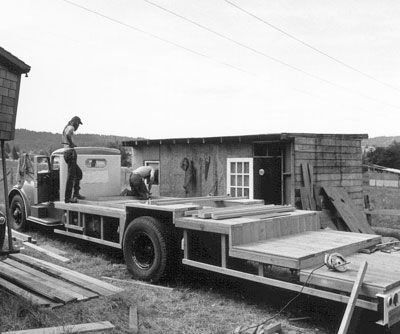
After being parked all winter and drawing the plans, summer arrived and it was time to begin construction. When the frame was lengthened, the layout of the sub floor was started using 4×4’s at two foot centers. The deck was laid on top, giving a solid sub floor. Before the floor was finished, the truck needed a new paint job, This was much easier to do before the house gets in the way.

Framing is done using 2×3 studs on 16″ centers, allowing a 4×8′ sheet of plywood to center on the studs. The wall and the skirt covering the tanks are sheathed with ½” plywood to add shear strength to the structure. It’s best to have your entry door and windows before you start framing so you know what size to build the openings for them.
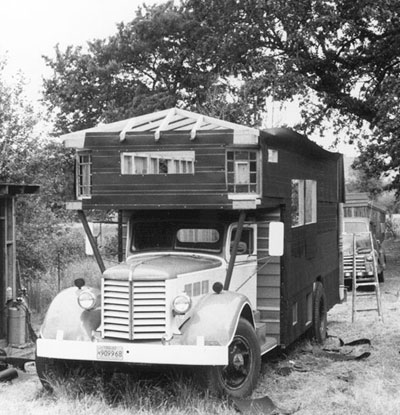
Starting at the bottom, tar paper is stapled up, covering the sides. Next, the windows are framed in, which takes time if you don’t want them to leak. Corner windows are put on a 45° angle to minimize wind resistance. I learned this first hand from having a housetruck with a flat front. Head winds would wipe me out!
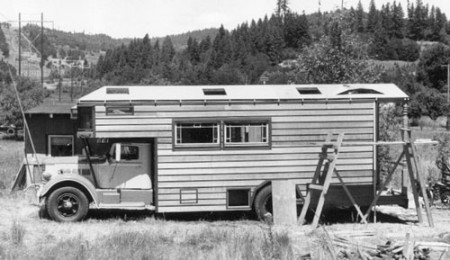
The bevel siding is added, starting from the bottom and working up. Like long shingles, each piece has to be cut to fit around windows and doors, straight and tight. The main roof is covered with 3/8″ plywood. The skylights are cut out, then framed in with 1×6″ wood, protruding through the roof. Removable, hatch-like covers with safety glass are made to fit over the frames.
Finish work is slow, but before long the insulation in the walls gets covered and things start looking better with new wood on the walls. With ceiling and walls finished, the cabinets are started so everything can be stashed away neat and tidy and out of the way. In many ways, a housetruck is like a boat.
Roger Beck built his first house car in 1969 and left L.A. heading north. In the next 7½ years, he traveled the Pacific Northwest doing art fairs, and building three more house trucks, each one getting larger. He also met many other house truck people along the way, and took lots of photos of their “mobile” homes.
He is currently the owner of a full-production cabinet shop, and enjoys collecting a variety of artifacts, including antique tin models of trucks, and has an awesome female action figure miniatures collection, among other things.
For additional information about ordering Some Turtles Have Nice Shells, stop by Roger’s web site at www.housetrucks.com, where you will find a 109 page virtual-tour of the building of his Federal house truck and many more photos of fine trucks and buses.
Some additional background on Roger and the book can be found at Mr. Sharkey’s Bus Barn:
Roger’s 1952 Federal Housetruck: http://www.mrsharkey.com/busbarn/roger/roger.htm
Newspaper article from Eugene, OR “Register Guard”: http://www.mrsharkey.com/busbarn/roger/rg.htm
Book review article from Eugene, OR “Eugene Weekly”: http://www.mrsharkey.com/busbarn/roger/ew.htm
The original book review of “Turtles”, from which this page was taken: http://www.mrsharkey.com/busbarn/roger/shells.htm
Also check out Sharkey’s Bus Barn site: http://www.mrsharkey.com/busbarn/
Written by Sharkey for the (Tiny House Blog)
If you enjoyed this post, subscribe to our feed

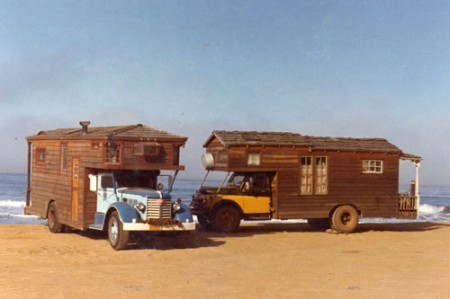
Love them! These old truck based tiny house have got so much style and class. Very different aesthetic to the trailer based tiny houses which scream house more than free spirit.
The only reason I think the trailer based tiny houses make more practical sense is that they are not physically attached to it’s powered mobility… so if the truck’s drive train were to break-down you’d be stuck until it were fixed.
Full-time RV’s know how this works first hand. When the rig is in the shop so is your home. A trailer based tiny house frees you from this additional dependency, but would have to work hard to give you the funky free-spirit style!
Same, i like being able to detach the vehicle too if you want to park in a safe place and go somewhere without the weight. However you can certainly make a trailer based house with class! Doesn’t have to be on a truck.
Awesome Post…Check out The Singing Landcruisers Blog… http://singinglandcruiser.blogspot.com/
What great vehicles. A log cabin on a truck, I don’t imagine it would survive a minor wreck, but you could always has a fantastic camp fire lol
Full of character these mobiles.
Just wanted to say that I read your blog quite frequently and I’m always amazed at some of the stuff people post here. But keep up the good work, it’s always interesting.
See ya,
Damn that’s a big stove for a house on wheels! I’ve been trying to find the tiniest stove possible, not easy if you want quality too. Maybe i should make the house a little bigger 🙂